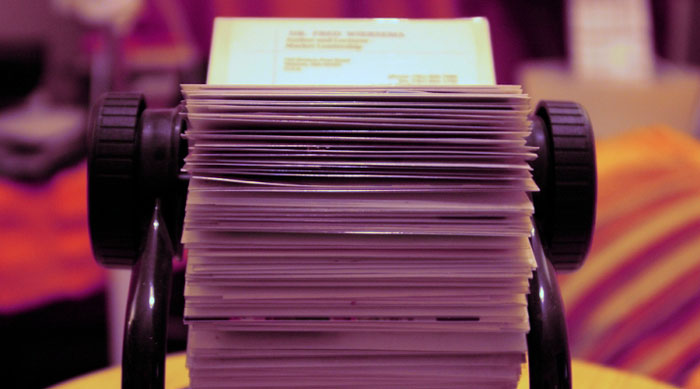
Good publicity can make your dreams come true, and that is just one of the reasons public relations agencies get 5-10k, or more, per month.
It’s not easy convincing TV stations, newspapers and magazines to quote you, much less feature you. Doing high quality press releases can still be very effective, and can occasionally lead to having a journalist write a story about you. But, in order to receive regular coverage, you have to reach out to journalists.
Back in the old days, good PR experts had a physical Rolodex worth its weight in gold. They built relationships with the media over time, and were able to call on them with story ideas. If you don’t have that kind of a list, you’re going to have to start building it on your own.
Buying lists of journalists’ names can be part of a full-scale PR strategy that can be highly effective, but if you want the low hanging fruit, I recommend using a service like PRleads.com or helpareporter.com. These websites can get you leads directly from journalists with deadlines to meet that are actively looking for experts to quote.
Why PR leads.com and ProfNet
The leads from PRleads.com come from ProfNet. ProfNet is part of the industry giant, PR Newswire, and gathers leads every day from reporters at the New York Times, Entrepreneur Magazine, Woman’s Day, CBS news and more. The leads share the stories that the journalists are writing, and what type of experts they would like to interview. The topics range from health, finance, women’s and legal issues, to technology, sales and more.
Are you worthy?
One of the key things to remember is that journalists actually want to talk to you, especially when they’re on a deadline. They can’t just quote themselves, and good stories require quotes from people like you. Think you’re not good enough? Think again. One of the most under looked parts of public relations is that sometimes you just have to be the expert that is available, not the expert that is the most knowledgeable.
If a journalist has a tight deadline, and the super high-level expert that they were going to interview bails out on them, then they are going to have to scramble to find someone else. If you contacted them politely and offered ideas of reasonable value, you will likely get the next call.
5 steps to regular success with prleads.com
-
Open an account
The first step is to open an account. Here are the options:
- Monthly Service Just $99/month
- Pre-Pay for 6 Months – Save $99
- Pre-Pay One Full Year – Save $238
One of the biggest differences between prleads.com and a service like HARO is the cost. I think there are over 250,000 people using the free version of HARO. Using a paid service like PRleads.com is going to make your life much easier, very quickly.
-
Select categories
Next you need to select the categories that make the most sense for your business. Keep in mind that sometimes you can spin it so that you fit into more categories than you would think.
PR lead Categories
- Arts / Entertainment / Media
- Banking / Personal Finance
- Computers / Telecom
- Corporate Social Responsibility
- Education
- General Industry
- Government / Public Issues
- Health / Medicine
- Law / Crime / Justice
- Living
- Management / Workplace
- ProfNet en Español
- EScience
- World Regions
-
Respond to leads, briefly and promptly
When leads come in they look like this:
The good news is that it shouldn’t take more than 15 to 30 minutes to follow up to an inquiry.
Example email
Here is an example of a response to a journalist’s specific questions that landed me in Econtent magazine about e-books.
“Hi Erik, I am John McDougall, author of the award-winning Web Marketing On All Cylinders. My company McDougall interactive, an elite Google partner, has been helping companies like Arrow Electronics, MIT, Phillips Medical and hundreds of others improve their SEO/website marketing since 1995. I have been featured in the New York Times, the Boston Globe/Herald and in numerous media and would love to help support you in any way I can.
1) For professionals who aren’t writers, how can creating a nonfiction e-book help boost their bottom line and profile?
Creating an e-book allows you to have an irresistible offer or what we call a top of the funnel call to action, so that people who are not ready to fill out your contact form, call you, or buy something from you yet, will be able to connect with you in a more comfortable way initially. The great news is that you can do audio interviews to generate the content easily.
2) Why is publishing a nonfiction e-book recommended for certain pros in the e-content/digital publishing industry?
An e-book can position you as a thought leader and shows that you care enough to help potential customers understand your industry.
3) What are the benefits/advantages? Why is it worthwhile, even if you’re not a skilled writer by trade?
Once you have the name and email address and ideally phone number of someone that downloaded your e-book, you can then market to them on a regular basis. If you can speak well about your business, then you can generate plenty of content through audio interviews. If you don’t want the e-book to be in an interview format, you can have a writer clean it up, so that it does not look like an interview. That is much easier than writing it yourself.”
I actually answered numerous other questions, which sometimes can be a mistake because you want to just pick the things you can respond best to. In this case it worked out well, and I think you get the idea from my first few responses.
I learned directly from Dan Janal, the founder of PRleads, to keep my responses short and do them more frequently. It is the journalist’s job to write the story, not yours, unless you are pitching specifically to write an article yourself. That is a different and more complicated PR tactic than just getting featured through quick quotes.
Another tip is to use a subject line that looks like this:
ProfNet: How Companies Are Using E-Books in Their Content Strategy
It should contain the word ProfNet at the beginning, so they know where it is coming from. Then it should have the title of the topic they have chosen. By using their language, they know to respond, as opposed to you pitching them on something random.
And don’t forget to start with a tiny bio that shows how you are an expert.
-
Spin it to get in it
You can also use what Dan Janal calls the magic hammer PR technique:
No matter what the question is, the answer is my topic.”
This only works if you do it in a way that makes sense, so don’t be thinking you can just cram yourself into any situation. However, a bigger mistake is not offering your interesting take on things that might be a little bit outside of your normal comfort zone.
-
Wear it on your sleeve
If you really want to be successful with public relations you have to extend it by making people aware of your media coverage. Nobody is going to ask you how often you have been featured in the media, so put it on your homepage, throughout your website, social profiles, as well as framed on the walls of your office.
How much success to expect
The typical conversion rate on a website is 1% to 2%. Out of every 100 people, you only get one or two people taking an action, unless you engage in conversion optimization. With PR leads.com, the good news is that it’s not uncommon at all to get 5% or 10% conversion rates. Often, for every 10 people you reach out to, you can get one interested in interviewing you if you use the PR strategies above. Some top PR experts get well above a 50% success rate.
Just remember to stand out from the crowd, because even with a paid service there are a lot of people pitching to be quoted in the same story.
The benefits of regular publicity can’t be underestimated. As Steve Harrison, a leading PR expert says, “Position yourself to be famous and you can have anything you want!”
What PR strategies or public relations tips and tricks have worked for you?
Check out these related PR podcasts:


 John McDougall: Welcome to the Authority Marketing Roadmap brought to you by workingdemosite.com/authority. Position yourself as an expert. I’m John McDougall, and I’m here to today with
John McDougall: Welcome to the Authority Marketing Roadmap brought to you by workingdemosite.com/authority. Position yourself as an expert. I’m John McDougall, and I’m here to today with  Dan Janal: It was early days. Early days. Good times. Good times. [laughs]
Dan Janal: It was early days. Early days. Good times. Good times. [laughs] Dan Janal: PR Leads is the original service that matches reporters and experts, so they can get publicity. Reporters are always writing stories. They’re always on deadline pression. They’re always looking for a couple of experts who can give them commentary, so they can write their stories.
Dan Janal: PR Leads is the original service that matches reporters and experts, so they can get publicity. Reporters are always writing stories. They’re always on deadline pression. They’re always looking for a couple of experts who can give them commentary, so they can write their stories.